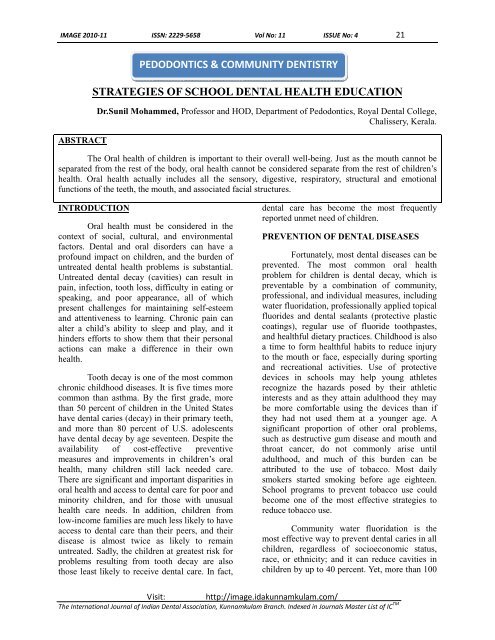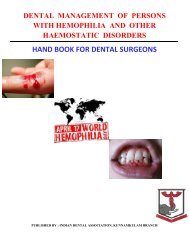'satisfactory smile' with a restorative approach - Indian Dental ...
'satisfactory smile' with a restorative approach - Indian Dental ...
'satisfactory smile' with a restorative approach - Indian Dental ...
You also want an ePaper? Increase the reach of your titles
YUMPU automatically turns print PDFs into web optimized ePapers that Google loves.
IMAGE 2010-11 ISSN: 2229-5658 Vol No: 11 ISSUE No: 4 21<br />
ABSTRACT<br />
STRATEGIES OF SCHOOL DENTAL HEALTH EDUCATION<br />
Dr.Sunil Mohammed, Professor and HOD, Department of Pedodontics, Royal <strong>Dental</strong> College,<br />
Chalissery, Kerala.<br />
The Oral health of children is important to their overall well-being. Just as the mouth cannot be<br />
separated from the rest of the body, oral health cannot be considered separate from the rest of childrenís<br />
health. Oral health actually includes all the sensory, digestive, respiratory, structural and emotional<br />
functions of the teeth, the mouth, and associated facial structures.<br />
INTRODUCTION<br />
PEDODONTICS & COMMUNITY DENTISTRY<br />
Oral health must be considered in the<br />
context of social, cultural, and environmental<br />
factors. <strong>Dental</strong> and oral disorders can have a<br />
profound impact on children, and the burden of<br />
untreated dental health problems is substantial.<br />
Untreated dental decay (cavities) can result in<br />
pain, infection, tooth loss, difficulty in eating or<br />
speaking, and poor appearance, all of which<br />
present challenges for maintaining self-esteem<br />
and attentiveness to learning. Chronic pain can<br />
alter a childís ability to sleep and play, and it<br />
hinders efforts to show them that their personal<br />
actions can make a difference in their own<br />
health.<br />
Tooth decay is one of the most common<br />
chronic childhood diseases. It is five times more<br />
common than asthma. By the first grade, more<br />
than 50 percent of children in the United States<br />
have dental caries (decay) in their primary teeth,<br />
and more than 80 percent of U.S. adolescents<br />
have dental decay by age seventeen. Despite the<br />
availability of cost-effective preventive<br />
measures and improvements in childrenís oral<br />
health, many children still lack needed care.<br />
There are significant and important disparities in<br />
oral health and access to dental care for poor and<br />
minority children, and for those <strong>with</strong> unusual<br />
health care needs. In addition, children from<br />
low-income families are much less likely to have<br />
access to dental care than their peers, and their<br />
disease is almost twice as likely to remain<br />
untreated. Sadly, the children at greatest risk for<br />
problems resulting from tooth decay are also<br />
those least likely to receive dental care. In fact,<br />
dental care has become the most frequently<br />
reported unmet need of children.<br />
PREVENTION OF DENTAL DISEASES<br />
Fortunately, most dental diseases can be<br />
prevented. The most common oral health<br />
problem for children is dental decay, which is<br />
preventable by a combination of community,<br />
professional, and individual measures, including<br />
water fluoridation, professionally applied topical<br />
fluorides and dental sealants (protective plastic<br />
coatings), regular use of fluoride toothpastes,<br />
and healthful dietary practices. Childhood is also<br />
a time to form healthful habits to reduce injury<br />
to the mouth or face, especially during sporting<br />
and recreational activities. Use of protective<br />
devices in schools may help young athletes<br />
recognize the hazards posed by their athletic<br />
interests and as they attain adulthood they may<br />
be more comfortable using the devices than if<br />
they had not used them at a younger age. A<br />
significant proportion of other oral problems,<br />
such as destructive gum disease and mouth and<br />
throat cancer, do not commonly arise until<br />
adulthood, and much of this burden can be<br />
attributed to the use of tobacco. Most daily<br />
smokers started smoking before age eighteen.<br />
School programs to prevent tobacco use could<br />
become one of the most effective strategies to<br />
reduce tobacco use.<br />
Community water fluoridation is the<br />
most effective way to prevent dental caries in all<br />
children, regardless of socioeconomic status,<br />
race, or ethnicity; and it can reduce cavities in<br />
children by up to 40 percent. Yet, more than 100<br />
Visit: http://image.idakunnamkulam.com/<br />
The International Journal of <strong>Indian</strong> <strong>Dental</strong> Association, Kunnamkulam Branch. Indexed in Journals Master List of IC TM



